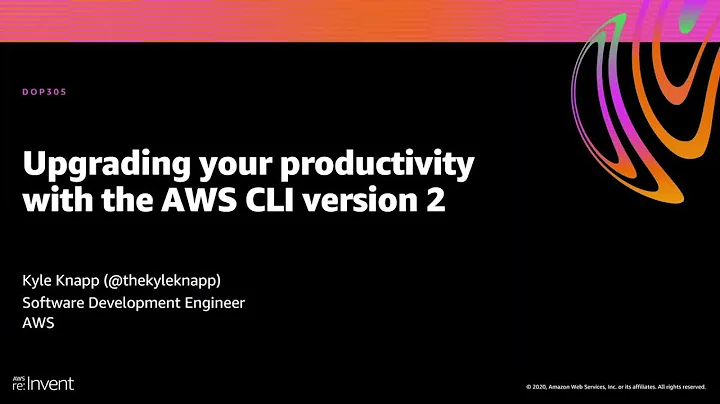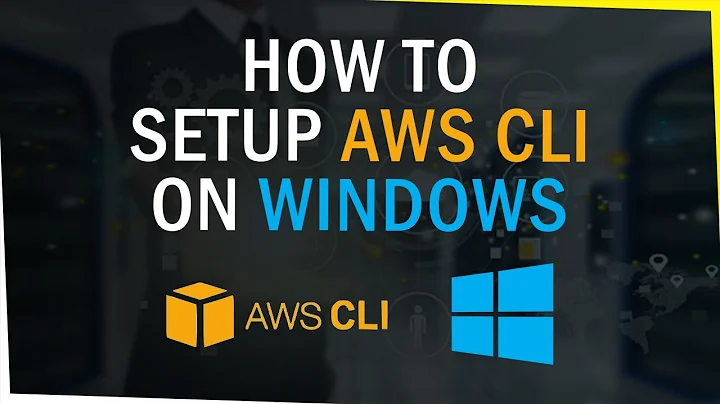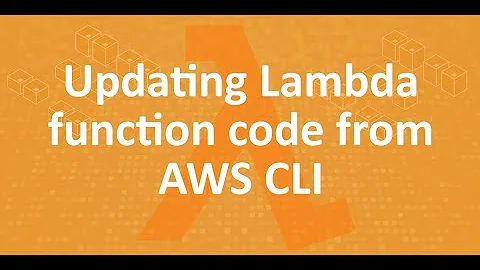How to upgrade AWS CLI to the latest version?
Solution 1
From http://docs.aws.amazon.com/cli/latest/userguide/installing.html#install-with-pip
To upgrade an existing AWS CLI installation, use the --upgrade option:
pip install --upgrade awscli
Solution 2
On Linux and MacOS X, here are the three commands that correspond to each step:
$ curl "https://s3.amazonaws.com/aws-cli/awscli-bundle.zip" -o "awscli-bundle.zip"
$ unzip awscli-bundle.zip
$ sudo ./awscli-bundle/install -i /usr/local/aws -b /usr/local/bin/aws
Solution 3
This does not work:
pip install --upgrade awscli
This worked fine on Ubuntu 14.04( no need to reboot also .. You would have to first install pip3 ):
pip3 install --upgrade awscli
Solution 4
For Ubuntu 16.04 I used parts of the other answers and comments and just reloaded bash instead of rebooting.
I installed the aws-cli using apt so I removed that first:
sudo apt-get remove awscli
Then I could pip install (I chose to use sudo to install globally with pip2):
sudo pip install -U awscli
Since I was doing this on a server I didn't want to reboot it, but reloading bash did the trick:
source ~/.bashrc
At this point I could use the new version of aws cli
aws --version
Solution 5
Update: Upgrade instance using AWS CLI v1 to AWS CLI v2:
This question and answer was initially created when there was only an AWS CLI v1. There is now a AWS CLI v2. The installation instructions for the AWS CLI v2 can be found here.
The new AWS CLI v2 has different installation instructions based on whether your EC2 instance is using Linux x86 (64-bit) or Linux ARM architecture.
To upgrade to AWS CLI v2, on an EC2 instance using Linux ARM, I had to issue the following commands:
rm -rf /bin/aws
curl "https://awscli.amazonaws.com/awscli-exe-linux-aarch64.zip" -o "awscliv2.zip"
unzip awscliv2.zip
./aws/install -i /usr/local/aws -b /bin
Subsequently test your AWS CLI version by executing: aws --version
For the Linux x86 (64-bit) architecture I'm hoping the commands are the same except for replacing the curl command with the following: (as per the installation instructions)
curl "https://awscli.amazonaws.com/awscli-exe-linux-x86_64.zip" -o "awscliv2.zip"
The AMI I used was the most recent one currently available and it was still using the AWS CLI v1. In the future if AWS starts packaging AWS CLI v2 with their AMIs this answer might require an update.
Original answer: Upgrade instance using AWS CLI v1 to use the most recent version of AWS CLI v1:
If you are having trouble installing the AWS CLI using pip you can use the "Bundled Installer" as documented here.
The steps discussed there are as follows:
$ curl "https://s3.amazonaws.com/aws-cli/awscli-bundle.zip" -o "awscli-bundle.zip"
$ unzip awscli-bundle.zip
$ sudo ./awscli-bundle/install -i /usr/local/aws -b /usr/local/bin/aws
Check your AWS CLI version subsequently as a sanity-check that everything executed correctly:
$ aws --version
If the AWS CLI didn't update to the latest version as expected maybe the AWS CLI binaries are located somewhere else as the previously-given commands assume.
Determine where AWS CLI is being executed from:
$ which aws
In my case, AWS CLI was being executed from /bin/aws, so I had to install the
"Bundled Installer" using that location as follows:
$ sudo ./awscli-bundle/install -i /user/local/aws -b /bin/aws
Related videos on Youtube
Borealis
Updated on February 22, 2022Comments
-
Borealis about 2 years
I recently noticed that I am running an old version of AWS CLI that is lacking some functionality I need:
$aws --version aws-cli/1.2.9 Python/3.4.3 Linux/3.13.0-85-genericHow can I upgrade to the latest version of the AWS CLI (1.10.24)?
Edit:
Running the following command fails to update AWS CLI:
$ pip install --upgrade awscli Requirement already up-to-date: awscli in /usr/local/lib/python2.7/dist-packages Cleaning up...Checking the version:
$ aws --version aws-cli/1.2.9 Python/3.4.3 Linux/3.13.0-85-generic-
Darren Reid over 6 yearsI had this same situation and was caused by the aws cli being originally installed via
apt-get install awscli. Solution was to remove it first (apt-get remove awscli) and followpip installanswers below. -
NKM over 5 yearsI did (apt-get remove awscli) but then after following (pip install...) commands I can't find the awscli executable. The output of (pip install ...) says successfully installed.
-
NKM over 5 yearsIf I don't use "--user" option in pip install then I could find awscli executable under /usr/local/bin (I am on Debian Jessie). But with --user option the exec is not available in ~/.local or in any of the python installation package folders (dist-package or site-package).
-
-
Borealis about 8 yearsI get the following message:
Requirement already up-to-date: awscli in /usr/local/lib/python2.7/dist-packages. Although when I runaws --version, I getaws-cli/1.2.9 Python/3.4.3 Linux/3.13.0-85-generic. -
RaviTezu about 8 yearsTry pip3 install --upgrade awscli
-
Borealis about 8 yearsRunning
sudo pip3 install --upgrade awscliand a reboot did the trick. Thanks for the help. -
JoeTidee over 7 yearsJust a reboot is required after installing aws cli.
-
toddkaufmann over 7 yearsI can't believe a reboot is required, but in this case it was faster to reboot my vm than find an alternative [that 'reboot voodoo' is for windows].
-
dannyman almost 7 yearsThis may require:
apt-get install python3-pipEither command works equally well for me on Ubuntu 14.04. -
B M over 6 yearsupdating via
pipdid not work for me - deletingawsand re-installing it this way did work. -
Lynn Langit over 6 yearsOn Mac OS, I had to run
sudo pip install --upgrade awsclifor my machine to be able to uninstall the previous version of the awscli (after the initial upgrade ran successfully) -
 zed over 6 yearsIf PyYAML failed you while installing:
zed over 6 yearsIf PyYAML failed you while installing:pip uninstall awscli, thensudo apt-get install python-devandpip install awscliagain. -
 Pratik Patel almost 6 yearsThanks for
Pratik Patel almost 6 yearsThanks forsource ~/.bashrcstep.:) -
Kannaiyan over 5 yearsYou saved my day. AWS is getting poor on its documentation.
-
 Remigiusz almost 5 yearsFor me helped going
Remigiusz almost 5 yearsFor me helped goingsudo sufirst. -
Kostanos almost 5 yearsyou don't need to reboot, just enter to another terminal, or restart the current one
-
hit3k over 4 yearsthis option worked for me as I needed to upgrade
/usr/local/aws( not/home/ubuntu/.local/bin/aws) to be used by jenkins user -
Chad Grant over 4 yearsusing the bundled installer somehow makes the resulting docker image LARGER than using pip ... mind blowing
-
Dick Chesterwood over 4 yearsIt may be necessary to open a new shell after installing - for some reason "aws" doesn't point to the new install until exiting and restarting.
-
Dick Chesterwood over 4 yearsThe documentation of AWS is indeed deteriorating rapidly. This is the correct answer, I can't understand why the questioner accepted an answer which they'd clearly stated in their edit didn't work - the pip packages are often behind the current latest which is a problem when using new stuff like EKS. Note: I had to exit the shell and log back in for the aws command to pick up the new version. No idea why.
-
Ankur Bhatia almost 4 yearsI now have aws and aws2 in my systems. How do I get rid of aws and rename my aws2 as aws?
-
AUR almost 4 yearson my jenkins machine I didn't want to explicitly uninstall the cli, so I used this method and worked like a charm!
-
Rahul about 3 yearsUntil unless used for a specific purpose, common day to day operations could easily be handled with Cloud shell
-
Peter Wiseman about 3 yearsInstead of reboot or starting another shell, you can run "hash -r" to clear the remembered utility locations. Or "hash aws" to reset just the remembered aws executable location.





